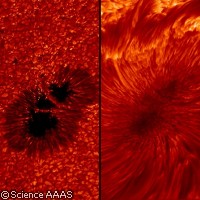Researchers reveal why Sun's atmosphere is hotter than its surface
EU-funded researchers in the UK and US have helped to solve the mystery of why the Sun's atmosphere is so much hotter than its surface. They discovered that waves of magnetic plasma, initiated in large 'bright point' structures on the Sun, are energetic enough to heat the corona. Their findings, which are published in the journal Science, provide valuable insights for research into the use of nuclear fusion here on Earth. The observations were an outcome of OPTICON ('Optical infrared coordination network for astronomy'), which brought together 47 research centres and was funded with EUR 19.2 million under the Research Infrastructures Thematic area of the EU's Sixth Framework Programme (FP6). The research group, led by David Jess of Queen's University Belfast in the UK, used the Swedish 1-m Solar Telescope (SST) to obtain their solar images. As its name suggests, the SST, operated by Sweden's Institute for Solar Physics on the island of La Palma in Spain, has a front lens diameter of 1 metre, making it the largest optical solar telescope in Europe. Its adaptive optics system counteracts blurring caused by the atmosphere, making it possible to observe and photograph extremely detailed images with minimal optical aberrations. The images obtained in the study were of approximately 80-kilometre resolution. 'We had 40 km on each pixel of our [...] camera, which is really unprecedented resolution,' said Dr Jess in an interview in the Science podcast. 'These are some of the sharpest images of the sun to date.' The detailed images allowed the researchers to look closely at a 'bright-point group', which is a 430,000-square-kilometre structure (roughly twice the size of the UK) on the sun's surface, to confirm the existence of Alfvén waves. 'An Alfvén wave is a wave that propagates from point A to point B, but only in a circular direction,' explained Dr Jess. 'Probably the best way to realise this is if you think of it as an elastic tube stretched between two points, and at one point you twist it in a circular motion and that causes the wave to move from point A to point B. The twisting will induce velocities.' Alfvén waves are purely magnetic plasma waves. Previous studies have demonstrated that they are strong enough to power the solar wind, but not powerful enough to heat the corona to millions of degrees. The new findings prove otherwise. The scientists were able to determine the velocities of the Alfvén waves by observing the Doppler motion of the plasma when undergoing a torsional twist. The velocities were incredibly high: well in excess of 20 km per second. While the bright-point group investigated represents only a small fraction of the sun's surface, such bright-point groups have been shown to be quite abundant. The particular point that the group analysed shows that Alfvén waves are definitely energetic enough to heat the corona. 'And of course, if these bright points, which are readily abundant, [...] all contain a similar mechanism, then the overall heating of the corona is possible with these waves,' Dr Jess stated. The findings explain how energy is transported from the surface of the sun to its outer atmosphere. The next step, according to the researchers, is to determine the energy that the bright points carry in a statistical study across the whole surface of the Sun. 'Only this way could we conclusively state that these bright points are energetic enough to solve the mystery of coronal heating,' said Dr Jess. The sun provides a constant source of nuclear fusion, which is an area of intensive global research. While the sun has sustained fusion reactions around the clock for millions of years, sustaining such reactions using terrestrial technology has been very problematic. 'One of the reasons the Sun can maintain this is because it has an efficient mechanism to transport its energy throughout the whole of its atmosphere,' said Dr Jess. Alfvén waves have been considered as a potential means to transport this energy, but it is only now that their existence has been confirmed. According to Dr Jess, 'This might open the door for helping people [...] to try to promote and sustain nuclear fusion reactions here on Earth, perhaps ultimately providing free energy.'
Countries
United Kingdom, United States



